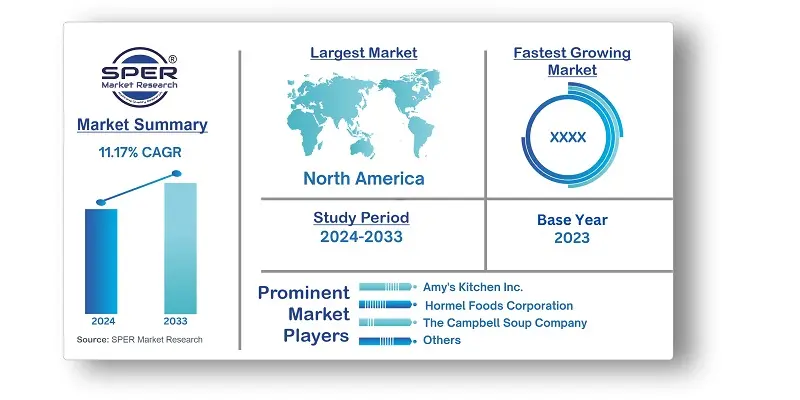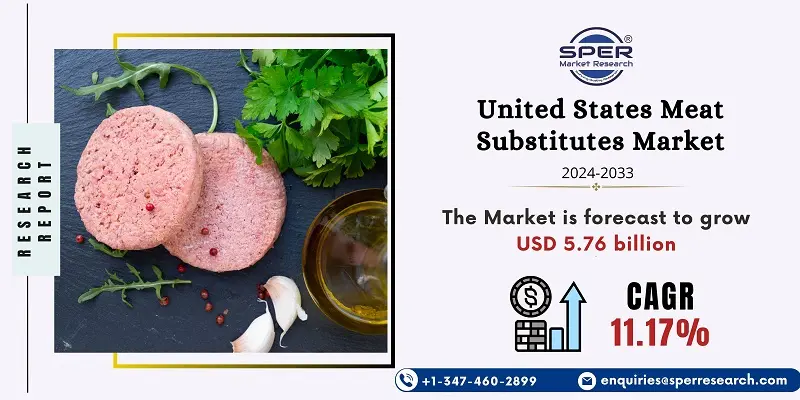
United States Meat Substitutes Market Trends, Share, Size, Demand, Revenue and Future Outlook
United States Meat Substitutes Market Growth, Size, Trends Analysis- By Type, By Distribution Channel- Regional Outlook, Competitive Strategies and Segment Forecast to 2033
| Published: Nov-2024 | Report ID: FOOD24121 | Pages: 1 - 106 | Formats*: |
| Category : Food & Beverages | |||
- September 2022: Wicked Kitchen, a North American company that sells plant-based products, has purchased Gathered Foods.
- Building on the recent introduction of Beyond Steak, Beyond Meat, a pioneer in plant-based meat, announced the April 2023 release of Beyond Pepperoni and Beyond Chicken Fillet.


| Report Metric | Details |
| Market size available for years | 2020-2033 |
| Base year considered | 2023 |
| Forecast period | 2024-2033 |
| Segments covered | By Type, By Distribution Channel |
| Regions covered | Eastern region, Western region, Southern region, Northern region. |
| Companies Covered | Amy's Kitchen Inc., Beyond Meat Inc., Conagra Brands Inc., Hormel Foods Corporation, Impossible Foods Inc., Maple Leaf Foods, The Campbell Soup Company, The Hain Celestial Group, Inc., The Kellogg Company, The Kraft Heinz Company, and Wicked Foods, Inc., along with a category for Others. |
- Health-Conscious Consumers
- Vegetarian and Vegan Communities
- Flexitarians
- Environmentally Conscious Shoppers
- Parents and Families
- Athletes and Fitness Enthusiasts
- Food Service Industry
- Retail Grocery Chains
| By Type: | |
| By Distribution Channel: |
- United States Meat Substitutes Market Size (FY’2024-FY’2033)
- Overview of United States Meat Substitutes Market
- Segmentation of United States Meat Substitutes Market By Type (Tempeh, Textured Vegetable Protein, Tofu, Others)
- Segmentation of United States Meat Substitutes Market By Distribution Channel (Off-Trade, On-Trade)
- Expansion Analysis of United States Meat Substitutes Market
- Problems and Obstacles in United States Meat Substitutes Market
- Competitive Landscape in the United States Meat Substitutes Market
- Impact of COVID-19 and Demonetization on United States Meat Substitutes Market
- Details on Current Investment in United States Meat Substitutes Market
- Competitive Analysis of United States Meat Substitutes Market
- Prominent Players in the United States Meat Substitutes Market
- SWOT Analysis of United States Meat Substitutes Market
- United States Meat Substitutes Market Future Outlook and Projections (FY’2024-FY’2033)
- Recommendations from Analyst
1.1. Scope of the report1.2. Market segment analysis
2.1. Research data source2.1.1. Secondary Data2.1.2. Primary Data2.1.3. SPER’s internal database2.1.4. Premium insight from KOL’s2.2. Market size estimation2.2.1. Top-down and Bottom-up approach2.3. Data triangulation
4.1. Driver, Restraint, Opportunity and Challenges analysis4.1.1. Drivers4.1.2. Restraints4.1.3. Opportunities4.1.4. Challenges4.2. COVID-19 Impacts of the United States Meat Substitutes Market
5.1. SWOT Analysis5.1.1. Strengths5.1.2. Weaknesses5.1.3. Opportunities5.1.4. Threats5.2. PESTEL Analysis5.2.1. Political Landscape5.2.2. Economic Landscape5.2.3. Social Landscape5.2.4. Technological Landscape5.2.5. Environmental Landscape5.2.6. Legal Landscape5.3. PORTER’s Five Forces5.3.1. Bargaining power of suppliers5.3.2. Bargaining power of buyers5.3.3. Threat of Substitute5.3.4. Threat of new entrant5.3.5. Competitive rivalry5.4. Heat Map Analysis
6.1. United States Meat Substitutes Market Manufacturing Base Distribution, Sales Area, Product Type6.2. Mergers & Acquisitions, Partnerships, Product Launch, and Collaboration in United States Meat Substitutes Market
7.1. United States Meat Substitutes Market Size, Share and Forecast, By Type, 2020-20267.2. United States Meat Substitutes Market Size, Share and Forecast, By Type, 2027-20337.3. Type7.3.1. Tempeh7.3.2. Textured Vegetable Protein7.3.3. Tofu7.3.4. Others
8.1. United States Meat Substitutes Market Size, Share and Forecast, By Distribution Channel (, 2020-20268.2. United States Meat Substitutes Market Size, Share and Forecast, By Distribution Channel (, 2027-20338.3. Off-Trade8.3.1. Convenience Stores8.3.2. Online Channel8.3.3. Supermarkets and Hypermarkets8.3.4. Others8.4. On-Trade
9.1. United States Meat Substitutes Market Size and Market Share
10.1. United States Meat Substitutes Market Size and Market Share By Region (2020-2026)10.2. United States Meat Substitutes Market Size and Market Share By Region (2027-2033)10.3. Eastern Region10.4. Western Region10.5. Southern Region10.6. Northern Region
11.1. Amy's Kitchen Inc.11.1.1. Company details11.1.2. Financial outlook11.1.3. Product summary11.1.4. Recent developments11.2. Beyond Meat Inc.11.2.1. Company details11.2.2. Financial outlook11.2.3. Product summary11.2.4. Recent developments11.3. Conagra Brands Inc.11.3.1. Company details11.3.2. Financial outlook11.3.3. Product summary11.3.4. Recent developments11.4. Hormel Foods Corporation11.4.1. Company details11.4.2. Financial outlook11.4.3. Product summary11.4.4. Recent developments11.5. Impossible Foods Inc.11.5.1. Company details11.5.2. Financial outlook11.5.3. Product summary11.5.4. Recent developments11.6. Maple Leaf Foods11.6.1. Company details11.6.2. Financial outlook11.6.3. Product summary11.6.4. Recent developments11.7. The Campbell Soup Company11.7.1. Company details11.7.2. Financial outlook11.7.3. Product summary11.7.4. Recent developments11.8. The Hain Celestial Group, Inc.11.8.1. Company details11.8.2. Financial outlook11.8.3. Product summary11.8.4. Recent developments11.9. The Kellogg Company11.9.1. Company details11.9.2. Financial outlook11.9.3. Product summary11.9.4. Recent developments11.10. The Kraft Heinz Company11.10.1. Company details11.10.2. Financial outlook11.10.3. Product summary
11.10.4. Recent developments
11.11. Wicked Foods, Inc11.11.1. Company details11.11.2. Financial outlook11.11.3. Product summary11.11.4. Recent developments11.12. Others
SPER Market Research’s methodology uses great emphasis on primary research to ensure that the market intelligence insights are up to date, reliable and accurate. Primary interviews are done with players involved in each phase of a supply chain to analyze the market forecasting. The secondary research method is used to help you fully understand how the future markets and the spending patterns look likes.
The report is based on in-depth qualitative and quantitative analysis of the Product Market. The quantitative analysis involves the application of various projection and sampling techniques. The qualitative analysis involves primary interviews, surveys, and vendor briefings. The data gathered as a result of these processes are validated through experts opinion. Our research methodology entails an ideal mixture of primary and secondary initiatives.



Frequently Asked Questions About This Report
PLACE AN ORDER
Year End Discount
Sample Report
Pre-Purchase Inquiry
NEED CUSTOMIZATION?
Request CustomizationCALL OR EMAIL US
100% Secure Payment






Related Reports
Our Global Clients
Our data-driven insights have influenced the strategy of 200+ reputed companies across the globe.






















